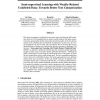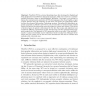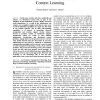1679 search results - page 3 / 336 » Learning Word Clusters from Data Types |
BMCBI
2010
13 years 7 months ago
2010
Background: Machine learning techniques have shown to improve bacterial species classification based on fatty acid methyl ester (FAME) data. Nonetheless, FAME analysis has a limit...
NIPS
2008
13 years 8 months ago
2008
The cluster assumption is exploited by most semi-supervised learning (SSL) methods. However, if the unlabeled data is merely weakly related to the target classes, it becomes quest...
JUCS
2002
13 years 7 months ago
2002
: WordNet (WN) is a lexical knowledge base, first developed for English and then adopted for several Western European languages, which was created as a machinereadable dictionary b...
CORR
2004
Springer
13 years 7 months ago
2004
Springer
Social insect societies and more specifically ant colonies, are distributed systems that, in spite of the simplicity of their individuals, present a highly structured social organi...
EUROGP
2010
Springer
14 years 15 days ago
2010
Springer
We describe a data mining framework that derives panelist information from sparse flavour survey data. One component of the framework executes genetic programming ensemble based s...



